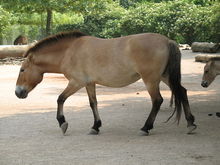In an important study, reported by By Gisela Telis in Science Magazine scientists sequenced the oldest genome to date.

A Przewalski's horse
The sequenced genome offers a glimpse at the ancient horse and how equine genes that are involved in immunity, the sense of smell, and muscle development have changed significantly since this ancient horse roamed the Yukon.
© 2016 by Lars Schmitt
Ancient DNA derived from a horse fossil that's between 560,000 and 780,000 years old suggests that all living equidsâmembers of the family that includes horses, donkeys, and zebrasâshared a common ancestor that lived at least 4 million years ago, approximately 2 million years earlier than most previous estimates.
The discovery offers new insights into equine evolution and raises the prospect of recovering and exploring older DNA than previously thought possible.
The study began with a walk in the permafrost. Evolutionary biologist Eske Willerslev of the University of Copenhagen joined a team of geologists on a 2003 expedition in Canada's Yukon Territory.
The group was exploring a site that holds ice and volcanic ash that date back more than 700,000 years. There, Willerslev spotted a piece of bone jutting from the frozen ground and decided he would study it.
The fossil, a fragment of horse leg bone, was too old for radiocarbon dating, but Willerslev estimated, based on its location in the permafrost, that it was between 560,000 and 780,000 years old. He and an international team of colleagues then set about scouring the fragment for any trace of collagen or other material that could harbor the ancient horse's DNA.
The odds were against the team. No DNA had been salvaged and sequenced from a fossil more than 130,000 years old (that was a polar bear jawbone), and theoretical estimates put the upper limit of DNA survival at about 1 million years.
Yet, a preliminary analysis of the sample hinted that it might contain a few remaining pockets of collagen and blood. Using the detailed, time-consuming process with which Willerslev sequenced an ancient human's DNA in 2010, the researchers were able to reconstruct the equid's genetic code.
For comparison, they also sequenced the genomes of a Late Pleistocene horse that lived about 43,000 years ago, a contemporary donkey, five different domestic horse breeds, and a Przewalski's horse, which is considered the world's only remaining wild horse and a source of controversy.
Genetically speaking, other so-called wild horsesâfor example, the mustangs of the American Westâare simply domesticated horses gone feral. Przewalski's horse is thought to be genetically distinct, but some experts have expressed doubt over whether this cousin of the domesticated horse carries some domesticated horse genes.
By comparing mutations across all the samples, the team determined that the fossil came from a male horse that lived about 700,000 years ago and most likely shared a common ancestor with the rest of the Equus lineageâall donkeys, horses, zebrasâabout 4 million to 4.5 million years ago. That finding alone may help settle a long-standing debate over Equus origins.
Experts disagree over the timeline of equine evolution and have posited that the last common Equus ancestor lived anywhere between 2 million and 6 million years ago. But the data, published online today in Nature, also solve another mystery. They suggest that the Przewalski's horse hasn't mingled genetically with domestic horse breeds, confirming that this endangered native of the Mongolian steppes really is distinct from its domesticated cousins.
As for what the ancient horse looked like, Willerslev says that he was large but not as tightly muscled as a modern horse. "This was a tall guy, on the order of Arabian horses," he says. "But I don't think he's something Napoleon would ride into town on."
The sequenced genome offers a glimpse at the ancient horse and how equine genes have evolved. Genes that are involved in immunity, the sense of smell, and muscle development have all changed significantly since this ancient horse roamed the Yukon, Willerslev says.
Beyond its implications for equine evolution, the study pushes the envelope for ancient DNA research, Willerslev says. "It was not that long ago that people in the field of ancient DNA would have said you can't retrieve data from something this old, but here we have a whole genome."
"There's no question this is a landmark study," says David Lambert, an evolutionary biologist at Griffith University in Australia who was not involved in the work. "It's well beyond the time period where I thought we had any prospect of getting a genome."
